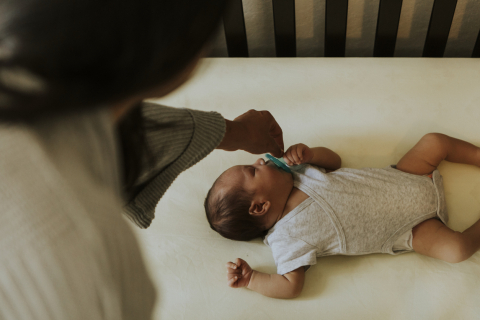
Safe Sleep Saves Lives
October is Sudden Infant Death Syndrome (SIDS) Awareness Month. Approximately 3,500 infants die annually in the United States from sleep-related infant deaths, including SIDS. This month, join NICHQ in raising awareness about safe sleep and breastfeeding recommendations.
All families want what’s best for their babies. That’s why it’s vital that health professionals empower families to openly discuss their concerns about safe sleep and breastfeeding recommendations with knowledgeable sources so they can make informed decisions about their caregiving.
- Share updated safe sleep recommendations from the American Academy of Pediatrics (AAP).
- Watch a recent Healthy Start Ambassador Training by the Healthy Start Technical Assistance and Support Center (TASC) where attendees learned the latest statistics, trends, and practices in safe sleep and risk reduction, including the American Academy of Pediatrics’ 2022 Recommendations for Reducing Infant Deaths in the Sleep Environment

Safe Sleep Resources & Tools
Check out NICHQ’s official online guide to ensuring safe infant sleep. We’re sharing the tools and knowledge to work toward eliminating SIDS and other sleep-related deaths. Find strategies and interactive resources to promote safe infant sleep guidelines, along with lessons learned to empower health professionals, community advocates, and families across the country to be champions of safe sleep.

Safe Sleep and Breastfeeding Community Learning
While sudden unexpected infant death (SUID) and breastfeeding are public health issues across population groups, significant disparities exist across race, ethnicity, and geography. To center the lived experiences of communities, many MCH programs are shifting to community-driven work to promote safe sleep and breastfeeding, including the National Action Partnership to Promote Safe Sleep Improvement and Innovation Network (NAPPSS-IIN). As NAPPSS-IIN concludes its fifth year of breastfeeding and safe sleep work, three key lessons have emerged about the value of community voice in breastfeeding and safe sleep quality improvement.
NICHQ will convene six Community of Practice (CoP) groups from September 2022-March 2023. CoPs include Birthing Professionals, Community Advocacy Organizations, Community-Based Home Visitors, Early Childcare Providers, First Responders, and Researchers. Each group will convene twice to continue to address policies, improve skills, and learn from each other’s experiences in the areas of safe sleep and breastfeeding.

Safe Sleep and Equity
Black, American Indian/Alaskan Native, and low-income families are disproportionately impacted by sudden unexpected infant death (SUID) and SIDS. These glaring inequities are rooted in systemic barriers caused by structural racism.
Read recommendations for how health professionals and improvement initiatives can better support the health and well-being of Black families from three NAPPSS-IIN faculty experts.
